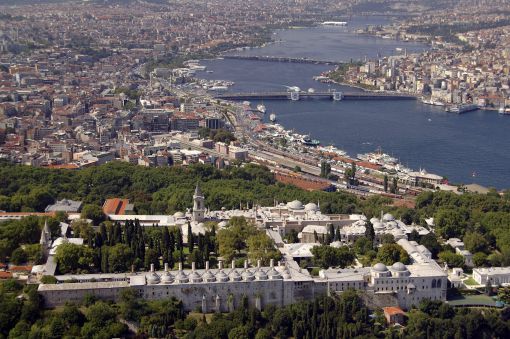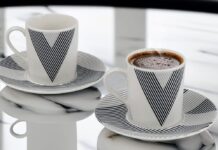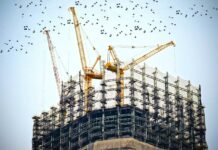Topkapı Palace, residence of Ottoman Sultans exhibiting imperial treasury, sacred Islamic relics of Prophet Mohammed, kitchen, Chinese porcelain, weapons, calligraphy section etc. Live guide commentary is not allowed in special sections. (Harem is not included in the program) Rüstem Paşa Mosque, designed by the court architect Sinan for the Grand Vizier of Süleyman The Magnificent. A typical sample of Islamic architecture amidst the rows of shops near the Spice Bazaar, famed with its exquisite and colorful tiles set in floral and geometric designs.

Tour of Topkapi Palace in Istanbul
Topkapi Palace and Museum is one of Istanbul’s museums that has gained great fame over the years, as it was the residence of the Ottoman Sultans for a long period of time estimated at 400 years.
The museum was built during the reign of Sultan Mehmed the Conqueror in the city of Istanbul specifically in Al-Fateh, where most of the historical monuments and tourist spots in Istanbul are located in a relatively high place, which gives it a unique view of the Golden Horn and the Bosphorus.
Historic importance of Topkapi palace
Topkapi Palace in Istanbul is known as the heart of the Turkish Empire, because it played an important and significant role during that period. As it was not only a place for the establishment of the Ottoman Sultans, but it was one of the places from which the most important political decisions came out, as well as it was visited by dignitaries at the world level.
Sections of Topkapi Palace
The palace consists of several sections, including the Salamlek section, the Haramlek section, the Hamayouni Diwan and the kitchen. All sections of the palace are distinguished by Islamic inscriptions and frescoes made of mosaic pieces, engravings in Arabic letters and beautiful gilded Quranic verses. This palace is a testament to the splendor of architecture in the Ottoman era.
the kitchen
The area of the kitchen is about 5000 square meters, and Turkey is currently famous for the diversity of its dishes and food, but what many people do not know is that most of these dishes appeared in the kitchen of Topkapi Palace, which was preparing food for about 15 thousand people daily.
Dressing room
In this hall, a large number of clothes dating back to the 29 Sultan who ruled the Ottoman Empire throughout the ages are now on display.
Salamlek
Salamlek is the section of royal eminence, which is entered into the gate of happiness, and in front of the gate of happiness was the inauguration ceremony of the sultans in the Ottoman Empire.
Command room
The command room is part of the salmuk, but it is the most important room in the topkapi palace, as the Sultan was using it to meet with ministers, ambassadors and foreign delegations, so most of the sultans took care of that room specifically, so they decorated it with the most beautiful and most luxurious decorations so that it shows through it the greatness of the Ottoman Empire in the hearts of foreign ambassadors .
The room also contained a special part in which all gifts received by the Sultan from foreign delegations were placed, and inside the room there was a specific point the Sultan used to sign death sentences, and he was signed in that room specifically.
Department of Holy Trusts
This section includes a group of Islamic antiquities, the most important of which are the sword of the Messenger Muhammad, peace be upon him, and its cold, and some other Islamic historical treasures, including a stick attributed to our master Moses, peace be upon him, and a stone on which the footsteps of our master Muhammad, peace and blessings be upon him, was presented. .
Wooden palace
It was a luxurious lounge overlooking the garden and overlooking the Bosphorus.
Sultan’s Pavilion
The Sultan’s wing was distinguished by the splendor of Islamic splendor and decorations, and it contained a dome overlooking the garden, and the Sultan was sitting underneath to eat, just as the Sultan’s suite contained a group of fountains, and the sultans are said to use them so that no one outside the room could hear the Sultan’s voice.
The Haramul section
The Haramlik section was used to establish the wife of the Sultan, his mother, brothers, and neighbors, and it is a huge section that contains three hundred rooms, two mosques, a school and several bathrooms, and the Haramluk women were not allowed to go to the markets, but the haremlik included a square in which the markets were held for the women of the palace. With a collection of exquisite Islamic motifs, distinguished by Arabic calligraphy and mosaics.
The Haramlik also had a swimming pool for women, and the Haramlik Mosque had a window for women to hear the voice of the imam in the men’s mosque.
The Humayouni Diwan
The Humayun Diwan was built during the reign of Sultan Suleiman the Magnificent, and it was ordered to be built to become the seat of the ministers, and the important orders of the Sultan were sealed and exited from this Diwan.
Hamayouni Gate
This door was built during the reign of Sultan Mehmed the Conqueror, and the door of Khumayoun or the Hamayouni Gate called the High Gate. It was the main entrance to the proximity and was close to the path of Sultan Ahmed, and a number of renovations were made in this section throughout the ages.
Did you Know?
Topkapi Palace is one of the most important historical landmarks of Istanbul, which you should not miss. and is a palace rich in culture and history…










